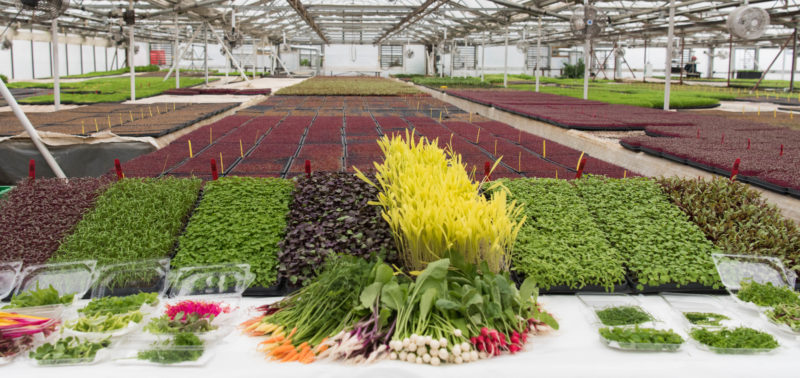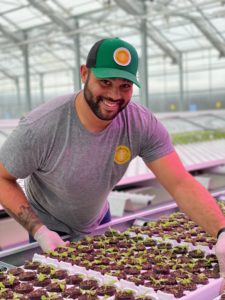
The Demand for Local & Sustainable Food
Contrary to the popular belief that artificial intelligence (AI) will eliminate swaths of jobs in the indoor farming industry and leave hundreds of people unemployed, the evidence just isn’t there. Unless, of course, you assume that the population growth of the U.S. remains stagnant and that American eating habits won’t continue trending toward fresher, not processed food. The increasing demand for food will be met with increasing supply.
The Bureau of Labor Statistics (www.bls.gov) already estimates 6% growth for agricultural and food science workers between 2018 and 2028, and this is without factoring in a boost from AI. Demand for farmers and ranchers is projected to drop 1% over the same period. The math is not in favor of outdoor farm expansion, it’s in favor of bringing more production under glass. As desirable agricultural farmland continues to dwindle, food security is going to have to come from somewhere, and the greenhouse industry is the logical choice, not overseas.
What is also changing is the way Americans purchase food, what types of food they are purchasing and how their eating habits are changing. The upward trends in the past decade have been in organic food consumption, as well as the demand for locally grown and sustainable food. According to the Pew Research Center (www.pewresearch.org), organic food consumption has been growing at a 10% rate for the past several years.
CONSUMERS WANT TO KNOW
Bob Jones, Jr. is a sixth-generation farmer and co-owner of The Chef’s Garden in Sandusky, Ohio, a combined farming and greenhouse operation.
“We sell to upscale restaurants and resorts, four and five-star locations, and we sell our products in all 50 states,” he says. “The product we are harvesting is delivered to the kitchen door of a restaurant within 15 hours; basically from the earth to your table. It’s produced domestically, it’s regulated by FDA, EPA, ODA. We know exactly how it’s produced, how it’s packaged and shipped, and we know how the people who produce it are treated.”
The reason this growth is occurring is that people want to know where their
food comes from, how it is grown and who is growing it.
“I think the bigger conversation is how is your food produced in this country, can we regulate it, how are the products being packaged and shipped, how are the people who work being treated?” Jones adds.
Why the focus on where produce is grown? According to a recent article in The Observer, “The agency [FDA] conducts physical border inspections on only 1 to 2% of food imports each year.” As American consumers learn that 98% of the food that is imported passes through customs faster than Americans coming back through the airport, the demand for local/domestic food will increase.
URBAN EXPANSION
Here’s another reason the industry is expanding.
Three years ago, Census Bureau Director John H. Thompson noted, “Rural areas cover 97% of the nation’s land area but contain 19.3% of the population (about 60 million people).”

That’s 80% of the country’s population who basically live in either urban or suburban areas. According to a Gallup poll two years ago, 73% of all Americans want their food grown locally. In 2018, the CDC investigated 23 multi-state illnesses, the highest amount in 12 years. Jason Maks, the owner of True Harvest Farms in Belton, Texas, talks about the changing food tastes in America.
“Combine the desire for locally grown food with the increase in public awareness of food safety issues, and you have two very strong reasons why growing food in a CEA manner is expanding rapidly in urban areas,” says Maks. “The consumer mindset is changing … it’s not that people aren’t eating lettuce, far from it. It’s that they don’t want to eat lettuce out of a field. I know I don’t want to give my kids something that’s going to make them sick, and I don’t think any other parent wants to do that either.”
MANAGING INCREASED DEMAND AND ECONOMIC VIABILITY
Where AI comes into play is in making it economically viable to locate a greenhouse close enough to an urban area that food can be delivered in a few hours. Consumers may want to have food produced locally and they may want it produced sustainably, but if the ROI isn’t there, growers aren’t going to do it.
According to the USDA Economic Research Service report released in December 2019, a staggering 31% of all food produced in the United States is lost. Computer vision and AI systems give growers the ability to predict what their yield will be with significantly higher accuracy than what exists in most operations today. Think about the figures that the industry currently accepts as acceptable for what’s commonly called scrap or dump, almost one-third, and then think
about significantly reducing that rate each year because optical scanners are able to monitor a plant from propagation to harvest.
As AI systems come into widespread use, that 31% loss figure will drop precipitously. Greenhouses, not vast farming operations will solve the problem of food deserts. Food will be produced more economically in the U.S. — and that’s what will generate the demand for more greenhouses and, thus, more greenhouse workers.
“I should be able to guide workers,” Maks says. “I’m not looking to reduce my labor force, I’m trying to utilize them so they can be more productive. I don’t want them doing a bug count manually, I’d much rather use them to treat problems they find. There’s really not an added value to have someone count bugs on a card; a machine can do that. But the human can look at the data and then make decisions on what to do.”
Artificial intelligence will drive the intersection of increased demand and economic viability in four key sectors: First, by reducing food waste; second, by increasing yield; third, by identifying pathogens and pests sooner; and fourth, by shifting workers out of looking for problems and into solving them. And, the beneficiary will be job growth and quality of life at every level of the industry.
Let’s give the USDA the last word on this discussion.
According to the USDA’s Economic Information Bulletin Number 216, published in January 2020, “These production systems (CEAs) also allow production schedules to synchronize to the timing of typical consumer demand patterns rather than to favorable weather patterns, which may also reduce waste through closer alignment of the timing of the demand and supply of perishable produce.”









 Video Library
Video Library 


















